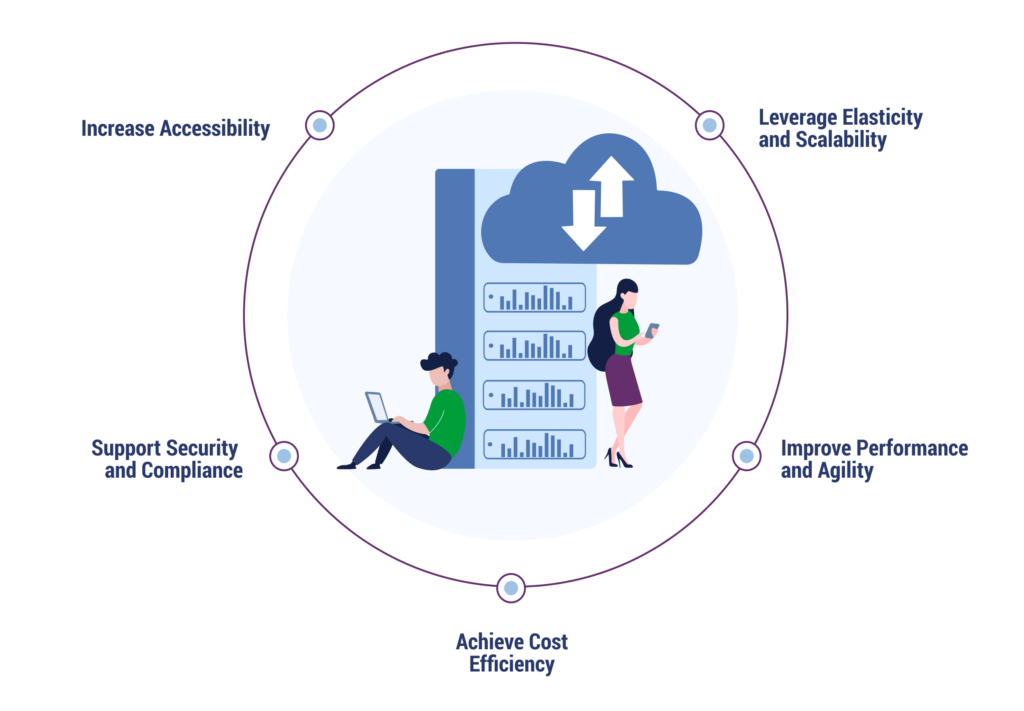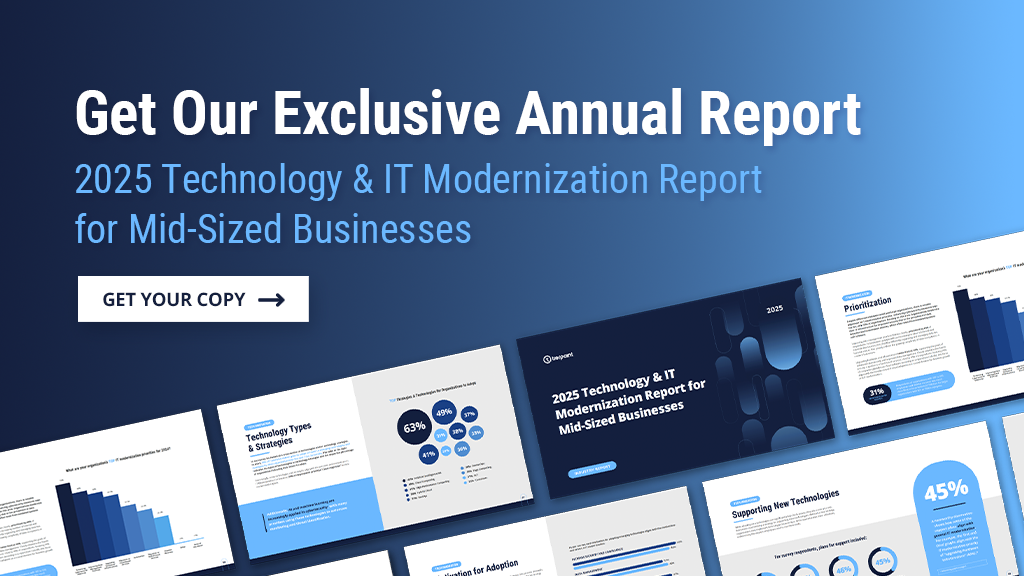
Moving from an on-premises environment to the cloud is almost always a one-way ticket. Although some businesses do engage in moving from the cloud to on-premises infrastructure, also known as cloud repatriation. 67% of organizations operate in a public cloud, and 47% of organizations are pursuing a cloud-first strategy according to O’Reilly’s most recent cloud adoption report . Cloud migration is top-of-mind for many, but the transition can be anything but seamless. We’ll discuss what an on-prem to cloud migration entails, the benefits businesses can enjoy, and the steps to think about when making the switch.
What is On-Prem to Cloud Migration?
An on-premises to cloud migration is when an organization moves its infrastructure, data, applications, and workloads from an on-premises data center to a cloud environment. This is often a move to public cloud provider, such as Amazon Web Services (AWS) or Microsoft Azure.
Why Migrate from On-Premises to Cloud?
Businesses may be compelled to migrate from an on-premises to cloud environment for many reasons. They may be looking to take advantage of new functionality and features offered by applications that are only available in the cloud. They may be looking to improve the performance of their IT environment.
Cloud environments can make businesses more agile by making it easier to deploy new applications and services. They can also help organizations improve their security posture with improved physical and infrastructural security measures.
Organizations may also be looking for a more cost-effective solution to replacing hardware and paying facility costs to maintain a data center as they shift from a CapEx to an OpEx approach. As more solutions are created with the cloud primarily in mind, organizations may find it more and more attractive to make the switch and transition out of the data center business.
Understanding the On-Prem to Cloud Migration Approach
The approach an organization takes to migrate to the cloud from an on-premises environment will depend on their current environment, their goals in a new environment, and the resources at their disposal. Common methods include lift and shift, refactoring, and replatforming.
Lift and shift, also known as rehosting, is when data and applications are moved from their current hosted on-premises environment to a cloud provider without any changes. While this can work for some workloads, others may lose functionality without additional configuration and development time.
Replatforming is the next step up in terms of effort, where workloads are moved to a cloud-based platform that is compatible with the on-premises platform. While the data and applications may require some adjustments to function in the cloud, the lift isn’t as significant as refactoring. Refactoring involves making changes to workloads to make them more suitable in the cloud. This can include altering the code, changing the architecture, or adjusting the way the data is formatted. Refactoring can be a time-consuming process, but it can also make it easier to grow and adapt in a cloud environment in the years to come.
Advantages of On-Prem to Cloud Migration
Conducting an on-premises to cloud migration comes with several advantages for a business, including boosts to accessibility, performance, cloud agility, scalability, cost savings, security, and compliance.

Leverage Elasticity and Scalability
When demand fluctuates, on-premises environments can struggle to keep pace. This is much easier to accomplish in cloud environments, where resources can be provisioned and deprovisioned on demand.
Improve Performance and Agility
The cloud delivers the essential infrastructure, tools, and services required to enhance performance, enabling organizations to scale efficiently, streamline costs, and prioritize their core business objectives. The flexibility of the cloud technology also empowers organizations with the agility to swiftly address market changes, customer needs, and emerging opportunities. This fosters a culture of rapid innovation, and the ability to quickly adapt to market shifts grants a competitive advantage.
Achieve Cost Efficiency
Managing an on-premises solution can be expensive for businesses. Not only are organizations responsible for handling the upfront capital expenditures related to the physical hardware, but they also need to handle facility costs, negotiate contracts with vendors, and pay for the maintenance of all data center components. While there may be cost-effective ways to do this, it’s often more efficient for businesses to work with a cloud provider and leverage pay-as-you-go pricing models so you only pay for the resources you actually use.
Support Security and Compliance
Transitioning to the public cloud offers organizations a dependable, secure, and compliant foundation, often surpassing what can be achieved on-premises in terms of security. By harnessing the security features, certifications, and tools provided by cloud providers, organizations can elevate their security stance, mitigate risk, and ensure alignment with industry and regulatory standards.
It’s crucial to remember, however, that while the cloud furnishes a secure foundation, organizations retain a shared responsibility for safeguarding their applications and data within the cloud environment.
Increase Accessibility
Even businesses that have returned to the office have still maintained some hybrid characteristics with 28% of employees working as part of a hybrid model as of 2023, and 13% of full-time employees working from home. With over 40% of employees spending part or all of their time working away from the office, accessibility to the systems at work is a must. Moving to the cloud can improve accessibility, allowing for easier logins and access on multiple devices.
On-Premises to Cloud Migration Steps You Should Take
Like any major business project, a strong assessment and plan at the beginning will be essential to avoiding any on-premises to cloud migration challenges.

Assessing and Planning the Migration
What does your current IT environment look like? What applications and data do you want to migrate? Take note of the hardware and software being used as well, and decide what will move and what may need to be replaced.
Choosing the Right Cloud Provider
The main differences between cloud providers can mostly be put in two categories: features and pricing. Your assessment and planning process should help you identify the features that are most important to meet your business objectives and support your applications. Price is important, but should be weighed alongside features. Maybe there’s something you can live without that will significantly reduce what you have to spend.
Migrating the Data
Once you’ve chosen a cloud provider and have outlined a plan, it’s time to migrate your workloads. This is a step that’s best done with the guidance of a cloud migration expert. These specialists offer invaluable best practices and are able to identify potential dependencies and challenges before other IT team members because of how often they engage in migration projects.
Testing and Optimizing the New System
Whether you migrated a small portion of your data and applications in a pilot program, or you’ve moved a larger piece of your environment, you should be testing with every step. Confirm everything is working properly after the migration is through, and monitor and optimize regularly to ensure the cloud infrastructure is cost-effective, efficient, and aligns with business objectives.
How to Migrate from On-Prem to AWS
Amazon Web Services (AWS) divides the on-premises to cloud migration process into the following phases: Assess, mobilize, migrate, and modernize.
During the assessment phase, organizations should evaluate their cloud readiness. They also need to make a business case for cloud migration and state what they hope to get out of moving to the cloud.
After that, it’s time to mobilize. Businesses will build a migration plan, find and fill gaps found during assessment, and build cloud skills. Applications may be dependent on each other or other tools in your environment in certain ways that may not immediately be obvious, but building a comprehensive cloud migration strategy can uncover these intricacies. Once assessment and mobilization are through, businesses will migrate their workloads to the cloud and modernize as necessary. This may be done with an all-internal team or with the help of cloud migration specialists.
How to Migrate from On-Prem to Azure
The process to migrate from on-prem to Microsoft Azure is not dissimilar to what you need to do for AWS. Microsoft does mention on their website that they have a centralized hub, Azure Migrate, used for server migration, and that migration options are also available for VMware VMs and Hyper-V VMs.
Make Your On-Prem to Cloud Migration Easy with TierPoint
Your on-premises to cloud migration project can be one of the most positive changes you make as a business, but it doesn’t come without its risks. Fortunately, you can skew the odds in your favor by bringing in cloud migration specialists. TierPoint’s experts have seen it all, so they can prevent you from making costly errors or missing a key component of the cloud migration process. Download our eBook to learn how you can maximize the cloud’s benefits while minimizing risks.
Finding the right cloud platform can be complex. Especially when understanding changes to various platforms, like VMware. At TierPoint, our certified experts have the experience needed to navigate the complexities of moving to cloud platforms, like Azure Stack, Azure Native, VMware, Azure VMware Solution, and AWS.
Don’t risk downtime or data loss—partner with us for tailored migration plans and 24/7 managed services that keep your transition efficient and secure. Start your cloud transformation today by scheduling a consultation with TierPoint, and let us help you unlock the full potential of your IT infrastructure while minimizing risks and maximizing your return on investment.


